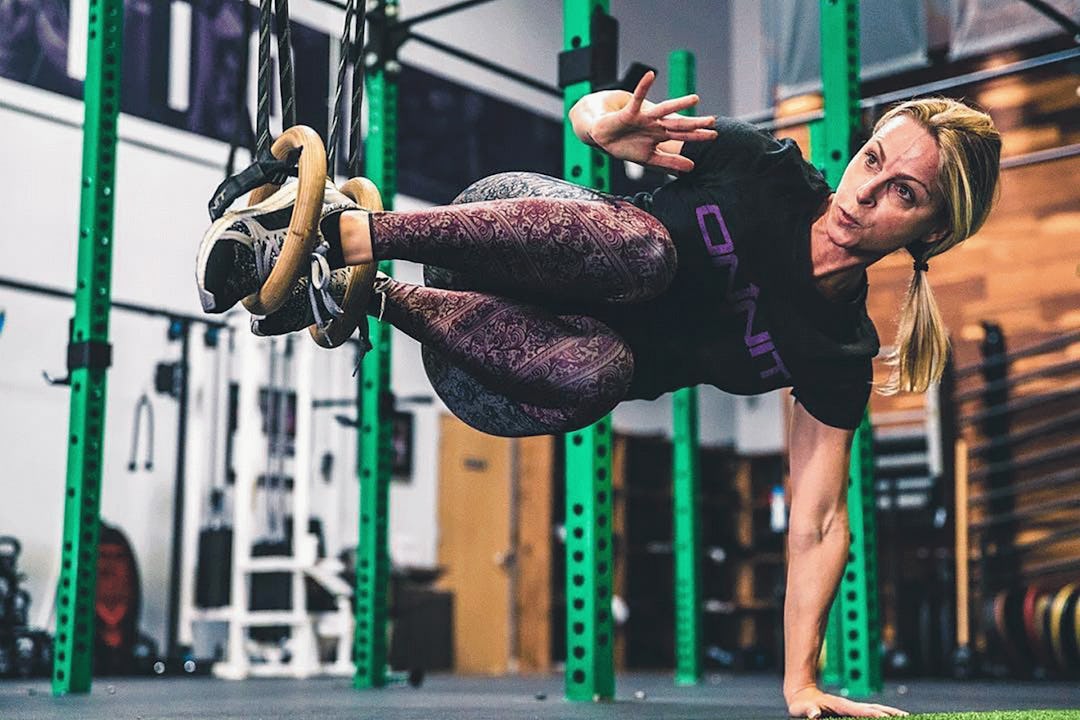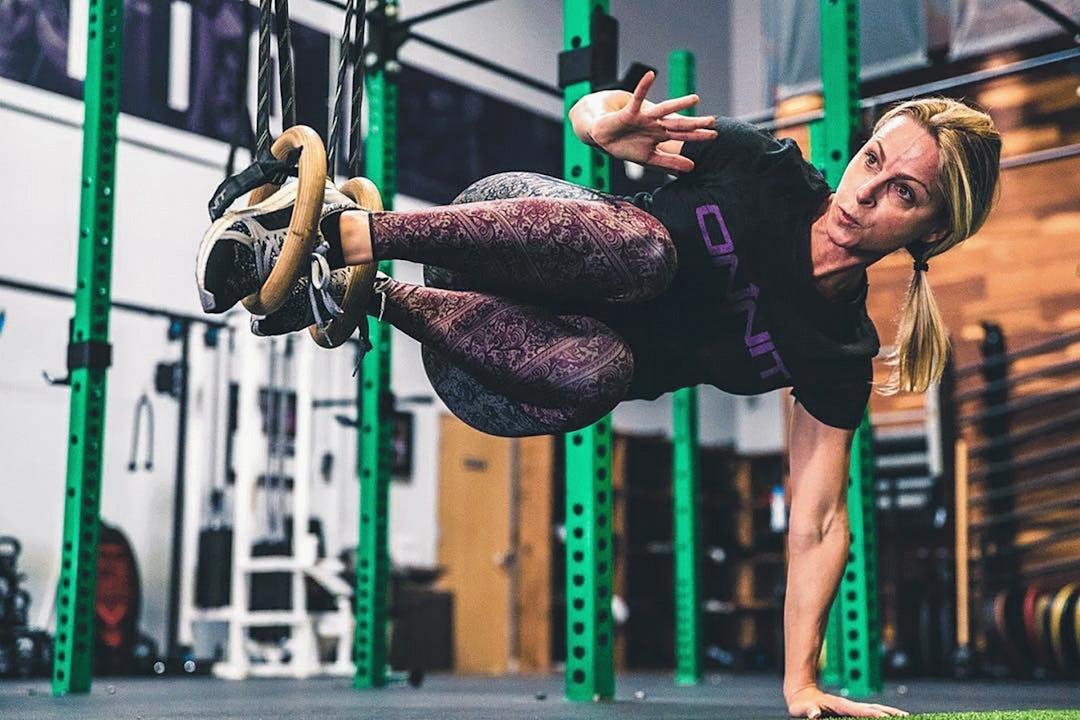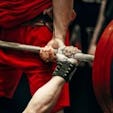Building and maintaining strong core muscles helps set the foundation for all aspects of fitness, whether your goals are purely functional (being able to lift your kid without hurting your lower back), aesthetic (hello, six pack abs!), or both. If you’re a mother who just had a baby, or you’re planning to, strengthening your core is extra important, as pregnancy can weaken the muscles in your belly and make getting back into shape postpartum that much harder.

Strengthen and Tone Your Core and Abs With These Workouts
Onnit consulted a core-training expert to create the best workouts for ladies of every level, beginner to advanced.
The 4 Pillars Of Core Training
According to Sarah Jamieson, CEO of Moveolution and co-creator of the Onnit Academy Durability Certification, core exercise can be filed into four different categories.
– Anti-Extension: These exercises make you work to resist extension at the spine (aka arching your back). Example: the classic plank.
– Anti-Lateral Flexion: These moves have you resisting sideways bending of the spine. Example: the side plank.
– Anti-Rotation: Resist rotation at the spine (twisting in either direction). Example: a Pallof press.
– Controlled Rotation: Rotate the spine purposefully (as opposed to being unable to control its twisting). Example: a cable woodchop.
You’ll notice that there’s no category for pure spine flexion, such as you would do in a crunch or sit-up exercise. This is not part of a safe and effective core training program, so we’re leaving it out (see “Why Are Situps Bad For You?” below).
Stick to the pillars above, and you’ll lay a foundation of core stability and strength that prevents injury and, of course, makes it possible to get lean, sexy abs.
Can I Do Core Workouts Daily?
One of the oldest myths in fitness is that you have to work abs every day in order to see the muscles and maintain a strong core. First of all, having visible ab definition comes down (almost entirely) to being lean. So if you want to see your abs, eat fewer calories and exercise until the fat burns off them. If you want a strong core, you should be conscious of how you’re using your abs every day, but you only need to train them hard and directly with the same frequency you would other muscles—two to three times per week.
“There are two kinds of core training,” says Jamieson, “core stability and core strength.” In many exercises, the two will be trained at the same time, but it’s important to understand the different ways in which your core works. “Core stability is the ability to stabilize the spine and pelvis,” says Jamieson. In any training you do, you always want to begin with your spine long, and maintain the natural arch in your lumbar. Your pelvis should be perpendicular to the spine, not tilted forward or back. When you move—or something else tries to move you—it’s your core stability that kicks in first to clamp down on the spine and pelvis, preventing them from going into positions that could hurt you.
“We work core stability naturally every day, and it should be worked daily,” says Jamieson, “but not necessarily in the gym.” Your posture plays a big role in maintaining core stability, so Jamieson suggests being more conscious of good body positions when doing your daily activities, including sitting and walking. Think about keeping your shoulders back and down (think: “proud chest”), your pelvis parallel with the floor, and your chin tucked, so that your head is in line with your spine. This can help reduce the risk of tight hips, lower-back pain, and many kinds of injuries. Jamieson also recommends daily diaphragmatic breathing that focuses on connecting your movements with breathing patterns. For examples of breath-work variations, visit Jamieson’s video library.
The counterpart to core stability is core strength, the ability to transmit force while the core is stabilizing the spine. (Take note of this: you need good core stability before you can build great core strength.) Think of building core strength like you do any other kind of strength—it’s intense training, and therefore doesn’t need to be done on a daily basis.
Core strength training includes all the moves you typically think of as “ab exercises,” but isn’t limited to just those. It can really comprise any exercise that relies on your core—even if the main focus of the exercise is on another area of the body. Squats, deadlifts, and overhead presses all depend heavily on the core muscles, and can help train core strength as well as give you a sharp set of abs (provided your body fat is low enough to see them).
There are two notable exceptions, however, that don’t belong in a core-training program: crunches and situps.
Why Are Situps Bad For You?
“I have a lot of clients who say, ’I want a six-pack,’” says Jamieson. “Well, that’s a great goal to have. However, we are not going to get there through exercises that flex the spine, because we know that is not the best way to train your core.” The problem with crunches and situps is that the motion flexes the spine, particularly the lower spine (lumbar). Done repeatedly over time, this can damage intervertebral discs in the spine and create lower-back pain. “Generally speaking, 80% of the population suffers from lower-back pain,” says Jamieson, “because of accumulated and/or compounding poor postural habits and movement dysfunction.” Adding more spinal flexion to the problem via our core training is like pouring gas on a fire.
Research from Harvard supports using plank variations over crunch and situp exercises to train the core more thoroughly and with less risk for injury.
Jamieson says to sprinkle core strength exercises (such as those that follow below) into the workouts you’re already doing a couple times per week, and focus on making big, functional exercises, such as deadlifts and farmer’s walks, the cornerstones of your workouts. They work your core in conjunction with lots of other muscles, helping you get better, faster results for the time you put in.
How Do I Get Started With Core Training?
If you’re new to core training, or just getting back into working out, you should start with exercises that use the floor to help you stabilize. The more of your body that’s in contact with the floor, the more stable your movements become, and the more feedback you get from your body on how you’re performing the exercise. These moves may not look too challenging, but you’ll feel them right away, and they’ll help you progress to even tougher moves.
*Always consult with your doctor before starting any exercise program, especially during pregnancy or following childbirth.
Beginner Core Exercise #1
Resistance Band Leg-Lowering
Step 1: Anchor a resistance band to a sturdy, stable object, such as a weight bench, power rack, or cable station.
Step 2: Lie flat on the floor with your head right behind the band. Tuck your tailbone under slightly to ensure your back is completely flat against the floor and that there is no arching of the spine.
Step 3: Start the move by driving the weight of your feet into the floor through your heels.
Step 4: Reach back and grasp the resistance band, raising it over your face. Now pull your arms down and forward toward your chest, keeping the wrists in line with the forearms. This will put tension on the band, and encourage your shoulders and trunk to stabilize your arms and body prior to executing the leg lift.
Step 5: Now raise your right leg up to 90 degrees, keeping your knee as straight as possible. Hold the position 5 seconds. Lower your leg, raise your arms back up to take tension off the band, and then repeat the entire movement. Do all your reps on one leg, and then work the other one on your next set.
Do sets of 5–10 reps.
Beginner Core Exercise #2
Bear Crawl
Step 1: Get on all fours with your feet flexed so your toes are touching the floor. Your shoulders should be directly over your wrists and your knees should line up with your hips.
Step 2: Brace your core and extend your knees slightly to raise them off the floor. Begin crawling forward, moving your left foot in time with your right hand, and then vice versa. Go forward a few steps, and then crawl backward. Each step is one rep.
While executing the movement, be mindful of maintaining a long spine and keeping the head, spine, and pelvis aligned. If you like, place a towel, block, or water bottle on your back to remind you to keep your back flat and core rigid.
Do sets of 5–10 reps.
How To Stretch Your Abs
Before doing a core workout, warm up with these moves to mobilize your back and hips, courtesy of Onnit Durability Coach Cristian Plascencia (@cristian_thedurableathlete on Instagram).
Beginner Core Workouts for Women
These workouts focus on developing stability in the core and lower back. They’re ideal for new moms who are ready to get their pre-pregnancy body back. Often times, pregnancy weakens the muscles and tissues that support the uterus and other pelvic organs. As a result, they can shift position. Strengthening the deep core muscles with the following movements helps things shape up down there.
Beginner Core Workout #1
Jamieson, a mother herself, says this routine can be done six weeks postpartum, and for up to three months. You can do it on its own day, or tack it on to the beginning or end of workouts you’re currently doing. Perform the routine two to three times per week.
Perform one set of each exercise in sequence, resting as needed between sets, and then repeat. So you’ll do one set of 1A, rest, then 1B, rest, 1C, rest, and repeat. Start with sets of 3–5 reps for each move, and repeat the exercises for 10 minutes. Add time each week, eventually building up to 10 reps per exercise and a 25-minute workout.
Pay constant attention to your pelvic position, and make sure to breathe intro your diaphragm so your belly expands 360 degrees (your chest and shoulders should not rise first). Breathing like this enhances your stability.
1A Upper-Body Rolling Pattern
Step 1: Begin by lying on the floor with your arms fully extended over your head. Tuck your pelvis so that your lower back flattens against the floor.
Step 2: Begin reaching your left arm across your face, just under your chin, keeping your other arm fully extended behind you. Brace your core. Slowly bring your arm to the other side of your body, twisting the torso. The lower body should remain motionless until the upper body pulls the lower body over. Be sure to keep your feet down on the floor—actively push them down as you twist. Pause here.
Step 3: Now extend your left arm, reaching forward for the direction you’ve been turning, and then slowly lead the rest of your body over, landing stomach down on the floor. Allow your feet to roll over when you can’t turn your shoulders anymore.
Step 4: Reverse the entire motion to return your body to the starting position, and then repeat to the opposite side.
One roll to each side equals one rep.
1B Functional Squat Progression 2
Step 1: Get on all fours and tuck your pelvis under slightly to create a long, neutral spine.
Step 2: Bring your right foot to the outside of your right hand, landing in a kneeling position (as in a mountain climber). Then raise your left foot up and place it back on the floor so it rests on the ball of your foot.
Step 3: Step forward with your left leg to move into the bottom of a squat. As you are shifting your leg, tilt your pelvis to see that it lines up with your spine as you plant your foot. Reach out with both arms to help you keep balance.
Step 4: Actively hold the bottom squat position for 3–5 seconds. Then raise your hips up slightly to create space to step back. Place your hands on the floor and take your left leg back to the starting position, resting your knee on the floor.
Step 5: Extend your torso up to a half-kneeling position, keeping your arms extended out front. Slowly return your whole body to the starting position.
A mountain climber into the squat on each side equals one rep.
1C Horned Deadlift
Step 1: Place a moderate-weight kettlebell on the floor between your feet.
Step 2: Stand tall, root your feet into the floor by twisting them outward slightly (but don’t let your feet move). Imagine twisting up some turf beneath your feet—you should feel your glutes fire up. Drive your arms down, reaching for the floor, to create muscular tension throughout the body.
Step 3: Keeping a slight bend in your knees, hike your hips back and reach for the kettlebell. Make sure your head, spine, and pelvis make a long straight line.
Step 4: Grip the kettlebell handle hard—try to crush it. Pull your shoulders down and together (think: “proud chest”) and take a deep breath into your belly. Brace your core.
Step 5: Explosively extend your hips and pull the kettlebell upward, sliding your hands around the horns as it rises until the weight settles at your chest and your forearms are vertical.
Step 6: Press the bottom of the kettlebell into your chest, being careful not to let your ribs flare (core stays tight). Keep your chest proud.
Step 7: Holding the weight tightly against you, hike your hips back again, pushing your weight onto your heels.
Step 8: Pause when you feel a stretch in your hamstrings, and then press the hips forward again to stand tall.
All of the above is one rep.
Beginner Workout #2
After you’ve mastered Beginner Workout #1, progress to this routine that can take you from the three-month mark forward. Perform the workout as you did the previous one, but do 10–15 reps per set (and each side) and train for 10 minutes. Add time each week.
1A KB Goblet Squat
Step 1: Stand behind a kettlebell, root your feet, and clean the weight up to chest level, as described in the horned deadlift exercise above.
Step 2: Actively pull your hips down to the floor, sitting back into a squat while you drive the knees forward and outward. Go as low as you can while keeping your head, spine, and pelvis aligned. If you feel your tailbone tuck under, stop there.
Step 3: Hold the bottom position 3–5 seconds, and then actively press the floor away to stand tall again.
1B Bear Crawl
See the directions under Beginner Core Exercise #2 above.
1C Single Arm Steel Club Carry
Step 1: Hold a moderate-weight steel club (five to 15 pounds) in your right hand, arm bent 90 degrees. Focus on stabilizing the club by keeping a firm grip and activating your arm muscles to keep the shoulder down and back, and your elbow close to your side.
Step 2: Tuck your pelvis under slightly and brace your core. Extend your left arm 90 degrees out to your side to help you balance, and then raise your left knee above hip level.
Step 3: Take a step forward while maintaining the stability in the arm holding the club. Repeat for 5 steps, and then switch arms.
Advanced Core Exercises
Once you’re dominating the exercises and workouts listed above, take your core training up a notch by adding these moves to your repertoire.
Advanced Core Exercise #1
KB Plank with Arm Raise
Step 1: Place two kettlebells on the floor, shoulder-width apart. Get into a pushup position with your hands on the kettlebells and feet out wide for a solid base of support. Your wrists must be straight, not flexed or extended. Tuck your tailbone under slightly, flex your glutes, and brace your core.
Step 2: Let go of one kettlebell and raise your arm straight out in front of you. As you raise it, keep your shoulder pulling back and downward—don’t shrug as you lift your arm. Hold the top for 2 seconds.
Step 3: Replace your hand on the kettlebell and raise the opposite arm.
Perform 5–10 reps per side.
Advanced Core Exercise #2
KB Renegade Row w/ Arm Raise
Step 1: Set up as you did for the plank with arm raise above. Be sure to hold the kettlebell handles in the middle.
Step 2: Raise your right arm up, as described in the plank with arm raise, and then grip the kettlebell again.
Step 3: Press into the floor as hard as you can with your left hand and foot, and then row the right-hand bell to your side. Squeeze your back muscles as you pull. Avoid twisting your shoulders or hips as you row, and bring your elbow tight to your waist.
Step 4: Lower the kettlebell back down and repeat on the opposite side.
Perform 5–10 reps per side.
Advanced Core Workout for Women
Perform the workout as an EMOM (Every Minute On the Minute) for 15 minutes. Start a timer and begin your first set of the first exercise at the top of the first minute. When you finish your reps, you have the rest of that minute to relax. Then you’ll do your first set of the second exercise (1B) at the start of the next minute. At the top of the third minute, do 1C. Repeat the exercises in that fashion until 15 minutes are up. Perform 10–15 reps per set.
1A Steel Club Deadstop Swing
Step 1: Hold a light- to moderate-weight steel club with both hands at the bottom of the handle.
Step 2: Keeping a slight bend in your knees, hinge at the hips, driving them back while you maintain a long spine with head and pelvis lined up. Extend your arms out long in front of you, but keep your shoulders pulled back and down.
Step 3: Lift your hips up slightly to create space to swing the club back in between your legs. Then drive your hips up and forward to propel the club up to shoulder height.
Step 4: Hinge at the hips again, breaking the speed of the swing by letting it come back between your legs and stop on the floor. Reset, and repeat.
1B KB Plank With Arm Raise
See the directions under Advanced Core Exercises above.
1C Double-Racked Crossover Farmer Carry
Step 1: Grasp two kettlebells whose combined weight makes a moderate load—30–50% of your total body weight.
Step 2: Hold the kettlebells by the handles with hands facing each other and resting your forearms on your chest.
Step 3: Engage your core by bringing your belly button up and into the body. Brace your core to support the weight. Cross your right foot over your left, and then step out with your left foot.
Step 4: Cross your right foot behind your left, and step out again. Stand tall and avoid bending in any direction while you move. Repeat for 10–15 reps in one direction and then repeat in the other.
15-Minute Core Workout, No Equipment
Perform each exercise for 45 seconds (on each side where applicable). Rest as little as possible between exercises. Repeat for 3 rounds, or until 15 minutes expires.
1A Downdog To Plank
Step 1: Get on all fours and then push your hips up and back into the downdog position. Your head, spine, and pelvis should form a long line and your arms should be straight and pressing into the floor. Bend your knees as needed, but keep your pelvis straight—don’t allow your lower back to round over. Hold for 5 seconds.
Step 2: Slowly extend your hips to lower into the top of a pushup (a plank). As you move to the plank position, pack your shoulders together and press your heels back to create a straight line with your body. Hold the plank for 5 seconds.
1B Cook Hip Lift
Step 1: Lie on your back with your knees bent about 90 degrees, feet planted on the floor and in line with your shoulders.
Step 2: Raise your left thigh to your chest and hug it in with your arms. If needed, pin a rolled-up towel in the crease of your hip to maintain the connection.
Step 3: Push through your right heel to raise your hips as high as you can. Pause at the top and lower your butt back to the floor.
1C Bear Crawl
See the directions under Beginner Core Exercises above.
1D Functional Squat Progression 3
Perform as you did the functional squat progression 2 (under Beginner Core Workout #1), but stand up tall after you get into the squat position. Then step back into the half-kneeling position.
1E Mountain Climber Hip Lift
Step 1: Get into the top position of a pushup and then bring your right knee to your chest, planting your foot on the floor (perform a mountain climber).
Step 2: Rotate your right foot away from your body and twist your torso to follow it as you lower your left hip to the floor. Your left leg should be fully extended with your right leg at a 90-degree angle over it.
Step 3: Plant your left hand on the floor and lift your hip off the floor as high as you can, reaching your right arm over your head at the same time. Be careful not to hyperextend your lower back. Keep your core braced so the movement comes from your hips and shoulder, not your spine.
Visit Sarah Jamieson at her Movelution website, or follow her on Instagram, @moveolution.

)





